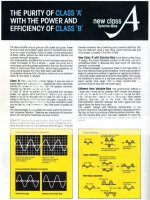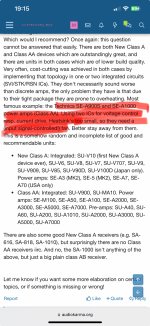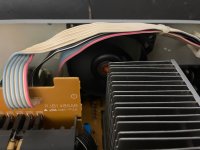Sorry that i messed up in my mind SuperA (jvc) with classAA. Its new classA i was thinking. I had many jvc amps with SuperA. JVC, Pioneer, Sansui, and others all solved crossover distortion their own way. More in this old thread.
hello,
would there be an intellectual property infringement if a company sells three small PCBs, or carrierboards, about 1.5 by 1.0 inch tall, fitted with SMDs, ready to use, providing each one a specific Class AB biaising scheme :
- "New Class A" bias module (see Technics folklore - synchro bias)
- "Super-A" bias module (see JVC folklore)
- "Non Switching" bias module (see Pioneer folklore)
The idea is to help hobbyists designing their own audio power amplifiers, making an effortless revival of the three non-switching class AB biaising methods. Hobbyists and designers would...
would there be an intellectual property infringement if a company sells three small PCBs, or carrierboards, about 1.5 by 1.0 inch tall, fitted with SMDs, ready to use, providing each one a specific Class AB biaising scheme :
- "New Class A" bias module (see Technics folklore - synchro bias)
- "Super-A" bias module (see JVC folklore)
- "Non Switching" bias module (see Pioneer folklore)
The idea is to help hobbyists designing their own audio power amplifiers, making an effortless revival of the three non-switching class AB biaising methods. Hobbyists and designers would...
- steph_tsf
- Replies: 231
- Forum: Solid State
In a nutshell, and if I'm not mistaken, Synchro Bias (a synonym for the later NewClass A) is a classic EF3 topology. And this topology follows the Blomley approach more closely, it has a small number of clamping and switching diodes.
This concept can also be described as ingenious, because the output stage never switches off (and/or on). Unfortunately, we DIYers cannot replicate this concept very well, because we simply don't have the right diodes. If you want to try something similar - the emphasis is on similar - then the only option is the Steve Dunlap concept called KRILL. The essence of the definition for both is that both complementary players never switch off -> this behavior can also be justifiably described as a type of A operation, but only correctly in push-pull mode -> and this is what is present, hence new Class A.
Class AA
is not synchronous bias, this term also fits better with other concepts; this was probably one reason for the concepts being renamed so soon - the obvious clamping diodes were already missing in the later implementations. Nevertheless, the technology used in the SE-A900 or the A1000 is more exciting and unfortunately also more vulnerable; in theory the two power amplifiers could also "switch" (on and off).
Hopefully the thread creator's beautiful amplifier will soon work reliably again, with relatively cold heat sinks.
The integrated units of the first mass series SU-V40, V50, V60 all have a heat pipe - their fins remain cold under all circumstances.
This concept can also be described as ingenious, because the output stage never switches off (and/or on). Unfortunately, we DIYers cannot replicate this concept very well, because we simply don't have the right diodes. If you want to try something similar - the emphasis is on similar - then the only option is the Steve Dunlap concept called KRILL. The essence of the definition for both is that both complementary players never switch off -> this behavior can also be justifiably described as a type of A operation, but only correctly in push-pull mode -> and this is what is present, hence new Class A.
Class AA
is not synchronous bias, this term also fits better with other concepts; this was probably one reason for the concepts being renamed so soon - the obvious clamping diodes were already missing in the later implementations. Nevertheless, the technology used in the SE-A900 or the A1000 is more exciting and unfortunately also more vulnerable; in theory the two power amplifiers could also "switch" (on and off).
Hopefully the thread creator's beautiful amplifier will soon work reliably again, with relatively cold heat sinks.
The integrated units of the first mass series SU-V40, V50, V60 all have a heat pipe - their fins remain cold under all circumstances.
But Ed,Sorry that i messed up in my mind SuperA (jvc) with classAA. Its new classA i was thinking. I had many jvc amps with SuperA. JVC, Pioneer, Sansui, and others all solved crossover distortion their own way. More in this old thread.
wasn't that an extremely exciting time? With wonderful amplifiers, I have fond memories of that decade. Full of exciting implementations and innovations.
all the best,
HBt.
I think we should all try to set up a forum Class AA (25 to 100W) amplifier.
But that's just a side note.
How can we help now?
But that's just a side note.
How can we help now?
I don't know the technical skills of OP, but Adason's idea to replace those capacitors might not be a bad idea.How can we help now?
Please note:
Never try to find the overload point (max swing), especially not without a connected static load of 8 or 4 ohms. Because the bootstrap (and the internal forces of the electric field...) will literally tear the semiconductors apart and the power transistors (whether BJT or MOS) will explode.
A friendly warning from practical experience.
The built-in and typical mains transformer usually falls into the voltage-sensitive fraction, its internal resistance is high, its losses are high, it gets warm.
But it must be wired or set to 240Vac mains. The old, 1980s 220Vac types are now a guarantee for provoked total failures - for several reasons that I don't want to list and explain in detail here.
Never try to find the overload point (max swing), especially not without a connected static load of 8 or 4 ohms. Because the bootstrap (and the internal forces of the electric field...) will literally tear the semiconductors apart and the power transistors (whether BJT or MOS) will explode.
A friendly warning from practical experience.
The built-in and typical mains transformer usually falls into the voltage-sensitive fraction, its internal resistance is high, its losses are high, it gets warm.
But it must be wired or set to 240Vac mains. The old, 1980s 220Vac types are now a guarantee for provoked total failures - for several reasons that I don't want to list and explain in detail here.
Yes, it was!But Ed,
wasn't that an extremely exciting time? With wonderful amplifiers, I have fond memories of that decade. Full of exciting implementations and innovations.
all the best,
HBt.
I moved to usa in 1996, i grew up in czechoslovakia. For me 80ties were the best.
I still have very old JVC hifi components in my old 'childroom' when i go visit relatives. It was nothing special, but it was my first hifi. Still working! I guess i posted pic somewhere, including the deck.
I gave my best Technics to my brother, he is using receiver daily.
Here in maryland i still keep jvc receiver, deck and cd player from that era. For nostalgia.
I hope to get to diyaudio soon. I sold house in maryland and will buy something in florida. I can't wait till i take my stuff out of storage.
thanks for the good answers my technical background is at beginner level but i am still learning but changing capacitors and soldering is no problem. but today i got my second a900s and it gets as hot as my first one, same with my a800s...
This is quite interesting, and at the same time strange, because then' the hybrid block of the current amplifier would probably have to contain two parallel MOS source followers with quite a large quiescent current... strange, very strange.
But this nut can definitely be cracked. I will research this and then report back here.
But this nut can definitely be cracked. I will research this and then report back here.
When does the fan engage? At idle, at high power (into the speakers), is it on all the time, or...?
Found this on audio karma : se the marked partThis is quite interesting, and at the same time strange, because then' the hybrid block of the current amplifier would probably have to contain two parallel MOS source followers with quite a large quiescent current... strange, very strange.
But this nut can definitely be cracked. I will research this and then report back here.
Attachments
Thanks, the fan control is interesting.
Not temperature dependent but assuming that if the input signal is high it has to cool.
Meanwhile, congrats with your collection, they are beautiful amps.
Not temperature dependent but assuming that if the input signal is high it has to cool.
Meanwhile, congrats with your collection, they are beautiful amps.
I don some testing, I replaced the original fan whit a 80mm noctua computer fan driven on a external power supply so it runs all the time and cranked it the volume to where I use to listen and after 2 hours the temperature on the heat sink is 35c… now i only have 1 problem and that is if I turn volume up to the point where the fan supposed to turn on the amp going into protection (cos it don’t find the original fan) is there a way to make a dummy fan load?
Attachments
The SVI3205B current amplifier is definitely a BJT Standard EF. According to the original Class AA doctrine, its power dissipation should not be significantly greater than 2 * 2.5W. 5W does not generate 60°C at the existing heat sink in idle mode. The left banger, the RSN6000B with its MOS fets will be the culprit. My guess is up to 2 * 20W (completely unnecessary) power dissipation. If this is really the case, then the temperature found is actually the normal state. With the maximum power output of 2 * 70Wrms (into 8 ohms), i.e. 140 to 45, this would be quite atypical.
An interesting case.
An interesting case.
- Home
- Amplifiers
- Solid State
- Technics SE-A900S



